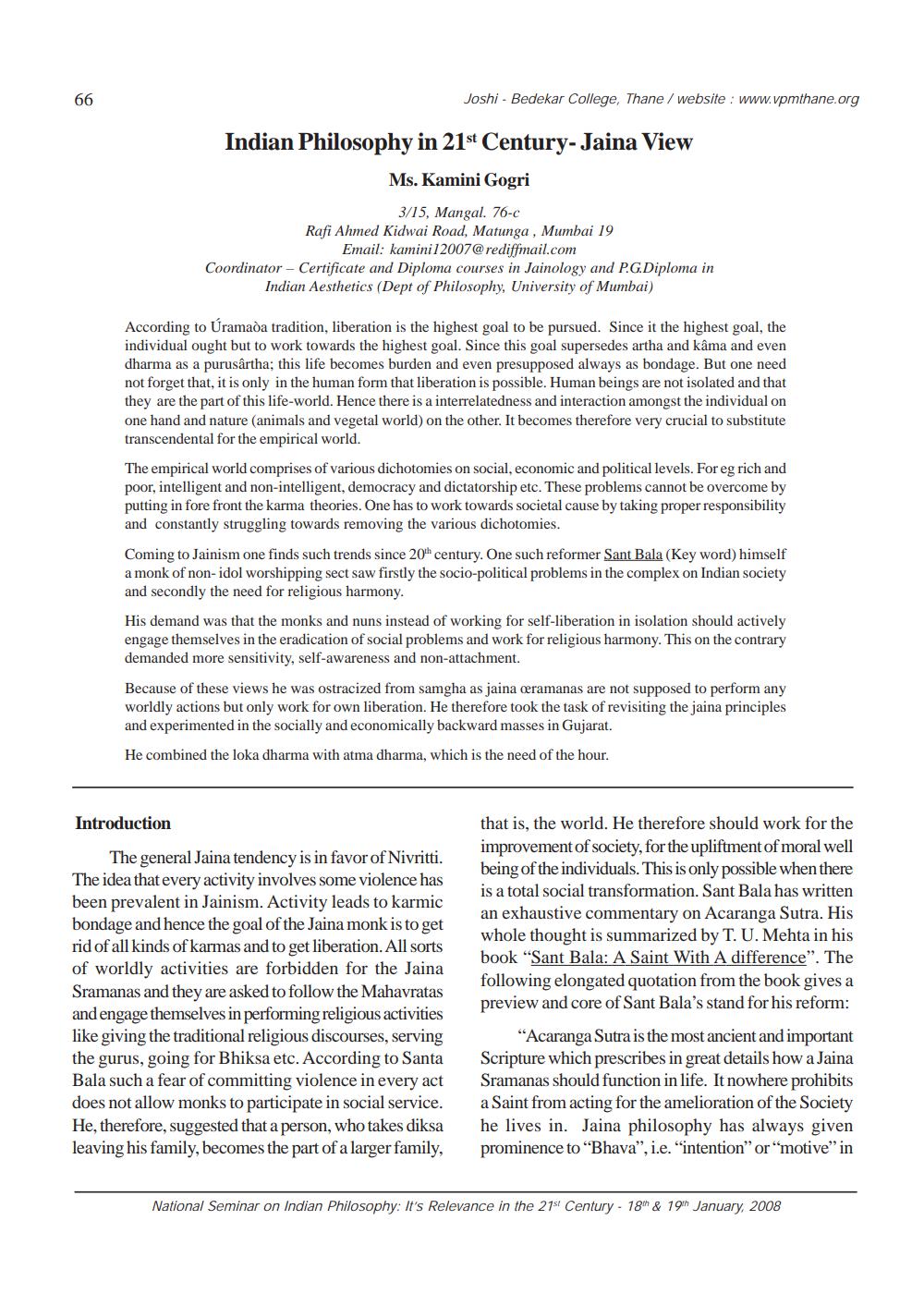________________
66
Joshi - Bedekar College, Thane / website : www.vpmthane.org
Indian Philosophy in 21st Century-Jaina View
Ms. Kamini Gogri
3/15, Mangal. 76-c Rafi Ahmed Kidwai Road, Matunga , Mumbai 19
Email: kamini l2007@rediffmail.com Coordinator - Certificate and Diploma courses in Jainology and P.G.Diploma in
Indian Aesthetics (Dept of Philosophy, University of Mumbai)
According to Úramada tradition, liberation is the highest goal to be pursued. Since it the highest goal, the individual ought but to work towards the highest goal. Since this goal supersedes artha and kama and even dharma as a purusârtha; this life becomes burden and even presupposed always as bondage. But one need not forget that, it is only in the human form that liberation is possible. Human beings are not isolated and that they are the part of this life-world. Hence there is a interrelatedness and interaction amongst the individual on one hand and nature (animals and vegetal world) on the other. It becomes therefore very crucial to substitute transcendental for the empirical world.
The empirical world comprises of various dichotomies on social, economic and political levels. For eg rich and poor, intelligent and non-intelligent, democracy and dictatorship etc. These problems cannot be overcome by putting in fore front the karma theories. One has to work towards societal cause by taking proper responsibility and constantly struggling towards removing the various dichotomies.
Coming to Jainism one finds such trends since 20h century. One such reformer Sant Bala (Key word) himself a monk of non-idol worshipping sect saw firstly the socio-political problems in the complex on Indian society and secondly the need for religious harmony.
His demand was that the monks and nuns instead of working for self-liberation in isolation should actively engage themselves in the eradication of social problems and work for religious harmony. This on the contrary demanded more sensitivity, self-awareness and non-attachment.
Because of these views he was ostracized from samgha as jaina ceramanas are not supposed to perform any worldly actions but only work for own liberation. He therefore took the task of revisiting the jaina principles and experimented in the socially and economically backward masses in Gujarat.
He combined the loka dharma with atma dharma, which is the need of the hour.
Introduction
The general Jaina tendency is in favor of Nivritti. The idea that every activity involves some violence has been prevalent in Jainism. Activity leads to karmic bondage and hence the goal of the Jaina monk is to get rid of all kinds of karmas and to get liberation. All sorts of worldly activities are forbidden for the Jaina Sramanas and they are asked to follow the Mahavratas and engage themselves in performing religious activities like giving the traditional religious discourses, serving the gurus, going for Bhiksa etc. According to Santa Bala such a fear of committing violence in every act does not allow monks to participate in social service. He, therefore, suggested that a person, who takes diksa leaving his family, becomes the part of a larger family,
that is, the world. He therefore should work for the improvement of society, for the upliftment of moral well being of the individuals. This is only possible when there is a total social transformation. Sant Bala has written an exhaustive commentary on Acaranga Sutra. His whole thought is summarized by T. U. Mehta in his book “Sant Bala: A Saint With A difference". The following elongated quotation from the book gives a preview and core of Sant Bala's stand for his reform:
"Acaranga Sutra is the most ancient and important Scripture which prescribes in great details how a Jaina Sramanas should function in life. It nowhere prohibits a Saint from acting for the amelioration of the Society he lives in. Jaina philosophy has always given prominence to "Bhava", i.e. “intention" or "motive" in
National Seminar on Indian Philosophy: It's Relevance in the 21st Century - 18 & 19 January 2008




